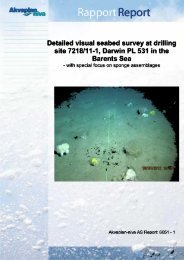A study of the priority substances of the Water Framework Directive ...
A study of the priority substances of the Water Framework Directive ...
A study of the priority substances of the Water Framework Directive ...
Create successful ePaper yourself
Turn your PDF publications into a flip-book with our unique Google optimized e-Paper software.
..:::::::::: lead and its compounds<br />
..:::52<br />
sumption and sales <strong>of</strong> seafood due to lead concentrations<br />
in Sørfjorden (all seafood), Harstad<br />
(liver and shell) and Årdalsfjorden (shellfish).<br />
Both swans and ducks are reported with lead<br />
poisoning between 1970 and 1990. Cod-liver in<br />
Inner Osl<strong>of</strong>jord has high and increasing lead<br />
burdens.<br />
Fresh water<br />
Several rivers have been monitored for lead pollution.<br />
High concentrations (class IV - V) were<br />
found in samples from Glomma,<br />
Numedalslågen, Orreelva and Vefsna. The lead<br />
concentrations in streams are not decreasing.<br />
Fresh water sediment<br />
The levels <strong>of</strong> lead are high in nearly all fresh<br />
water sediment in Norway. Atmospheric pollution<br />
is a significant source, in addition to mining<br />
and local industry.<br />
Fresh water biota<br />
The lead levels in trout in Vefsna are higher<br />
than from o<strong>the</strong>r rivers. There are not many<br />
studies on fresh water biota.<br />
Need for fur<strong>the</strong>r screening and monitoring<br />
Lead is thoroughly screened and <strong>the</strong>re is no fur<strong>the</strong>r<br />
need for screening. However, monitoring <strong>of</strong><br />
lead concentrations should continue, both<br />
because environmental levels are high and in<br />
order to evaluate measures and policies for lead<br />
reduction, such as <strong>the</strong> banning <strong>of</strong> lead in shotgun<br />
ammunition.<br />
Localities for fur<strong>the</strong>r screening and monitoring<br />
The monitoring <strong>of</strong> lead should be continued in<br />
<strong>the</strong> same localities which have been monitored<br />
earlier.<br />
Analysis<br />
There are several well-established techniques for<br />
determination <strong>of</strong> Pb. Several companies <strong>of</strong>fer<br />
this service in Norway and Europe. The most<br />
common techniques are inductively coupled<br />
plasma mass spectrometry (ICP-MS), inductively<br />
coupled Plasma Atomic Emission Spectroscopy<br />
(ICP-AES), Graphite Furnace Atomic<br />
Absorption Spectroscopy (GF-AAS) and Flame<br />
Atomic Absorption Spectroscopy (F-AAS).<br />
Methods<br />
<strong>Water</strong> samples are acidified with 1-10% nitric<br />
acid.<br />
A <strong>study</strong> <strong>of</strong> <strong>the</strong> <strong>priority</strong> <strong>substances</strong> <strong>of</strong> <strong>the</strong> <strong>Water</strong> <strong>Framework</strong> <strong>Directive</strong><br />
TA-2140/2005<br />
For analysis <strong>of</strong> solid samples, <strong>the</strong> methods are<br />
based on digestion with nitric acid / hydrogen<br />
peroxide in sealed containers using microwave<br />
system.<br />
Synergy with o<strong>the</strong>r analyses<br />
The sample digestion method used for determination<br />
<strong>of</strong> lead can also be used for determination<br />
<strong>of</strong> Cu, Hg, Ni, Zn, Cr and As.<br />
References<br />
� CIRCA, Royal Haskoning Fact sheets on production,<br />
use and release <strong>of</strong> <strong>priority</strong> <strong>substances</strong> in<br />
<strong>the</strong> WFD, Lead, Final version 31 January 2001.<br />
� WHO International programme on chemical<br />
safety. Environmental health criteria 3 Lead.<br />
Geneva 1977<br />
� HSDB: Lead.<br />
� Miljøstatus, Bly.<br />
� SFT- communication 22.11.05<br />
� Overvåking av miljøgifter i marine sedimenter<br />
og organismer, 1981-1999. Joint Assessment<br />
and Monitoring Programme (JAMP), TA-1797-<br />
2001.<br />
� Sonderende undersøkelser i norske havner og<br />
utvalgte kystområder. Fase 1. Miljøgifter i sedimenter<br />
på strekningen Narvik-Kragerø. TA-<br />
1159/1994.<br />
� Sonderende undersøkelser i norske havner og<br />
utvalgte kystområder. Fase 2. Miljøgifter i sedimenter<br />
på strekningen Stavern-Hvitsten. TA-<br />
1160/1994.<br />
� Sonderende undersøkelser i norske havner og<br />
utvalgte kystområder. Fase 3. Miljøgifter i sedimenter<br />
på strekningen Ramsund-Kirkenes. TA-<br />
1215/1995.<br />
� National Comments regarding <strong>the</strong> Norwegian<br />
data for 2003. Joint Assessment and Monitoring<br />
Programme (JAMP), rapport 921/2004.<br />
� Miljøgifter og radioaktivitet i norsk fauna -<br />
inkludert Arktis og Antarktis, utredning for DN<br />
nr. 1999-5.<br />
� Heavy metals and persistent organic pollutants<br />
in sediments and fish from lakes in<br />
Nor<strong>the</strong>rn and Arctic regions <strong>of</strong> Norway, rapportnr.<br />
688/97.<br />
� Miljøgifter i marine sediment og organismer i<br />
havneområdene ved Harstad, Tromsø,<br />
Hammerfest og Honningsvåg 1997-98, TA-<br />
1697/2000.<br />
� Miljøgifter i fisk, skalldyr og sediment i havneområder<br />
og fjorder i Rogaland 1999-2000.<br />
TA-1843/2001.

















